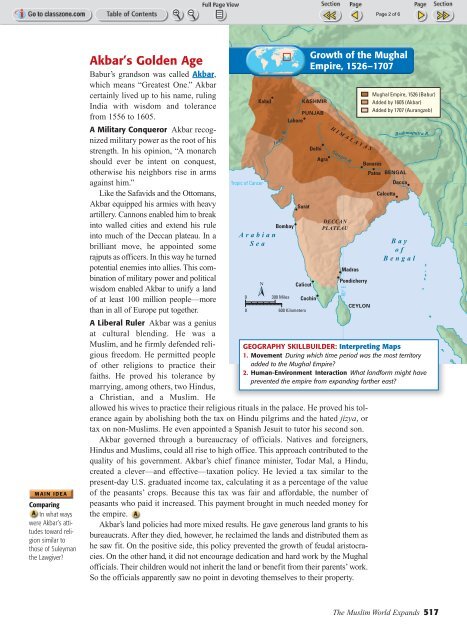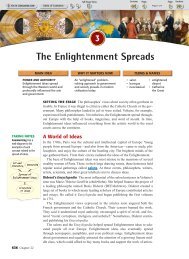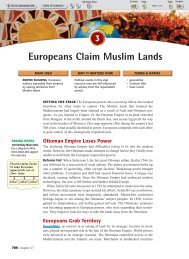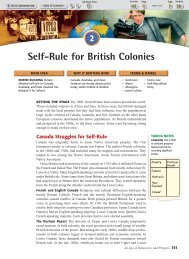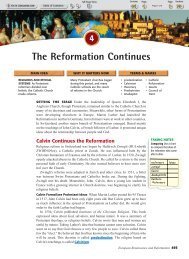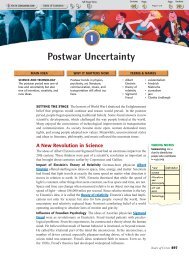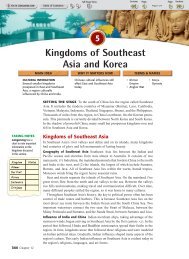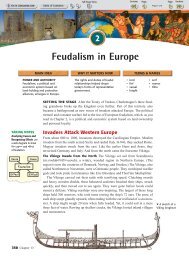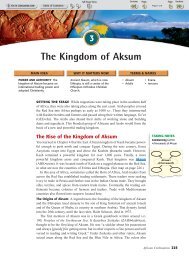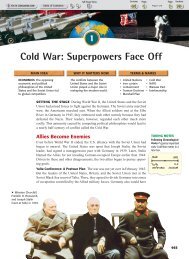Create successful ePaper yourself
Turn your PDF publications into a flip-book with our unique Google optimized e-Paper software.
Compar<strong>in</strong>g<br />
In what ways<br />
were Akbar’s attitudes<br />
toward religion<br />
similar to<br />
those of Suleyman<br />
the Lawgiver?<br />
Akbar’s Golden Age<br />
Babur’s grandson was called Akbar,<br />
which means “Greatest One.” Akbar<br />
certa<strong>in</strong>ly lived up to his name, rul<strong>in</strong>g<br />
<strong>India</strong> with wisdom and tolerance<br />
from 1556 to 1605.<br />
A Military Conqueror Akbar recognized<br />
military power as the root of his<br />
strength. In his op<strong>in</strong>ion, “A monarch<br />
should ever be <strong>in</strong>tent on conquest,<br />
otherwise his neighbors rise <strong>in</strong> arms<br />
aga<strong>in</strong>st him.”<br />
Like the Safavids and the Ottomans,<br />
Akbar equipped his armies with heavy<br />
artillery. Cannons enabled him to break<br />
<strong>in</strong>to walled cities and extend his rule<br />
<strong>in</strong>to much of the Deccan plateau. In a<br />
brilliant move, he appo<strong>in</strong>ted some<br />
rajputs as officers. In this way he turned<br />
potential enemies <strong>in</strong>to allies. This comb<strong>in</strong>ation<br />
of military power and political<br />
wisdom enabled Akbar to unify a land<br />
of at least 100 million people—more<br />
than <strong>in</strong> all of Europe put together.<br />
A Liberal Ruler Akbar was a genius<br />
at cultural blend<strong>in</strong>g. He was a<br />
Muslim, and he firmly defended religious<br />
freedom. He permitted people<br />
of other religions to practice their<br />
faiths. He proved his tolerance by<br />
marry<strong>in</strong>g, among others, two H<strong>in</strong>dus,<br />
a Christian, and a Muslim. He<br />
Tropic of Cancer<br />
PUNJAB<br />
Lahore<br />
allowed his wives to practice their religious rituals <strong>in</strong> the palace. He proved his tolerance<br />
aga<strong>in</strong> by abolish<strong>in</strong>g both the tax on H<strong>in</strong>du pilgrims and the hated jizya, or<br />
tax on non-Muslims. He even appo<strong>in</strong>ted a Spanish Jesuit to tutor his second son.<br />
Akbar governed through a bureaucracy of officials. Natives and foreigners,<br />
H<strong>in</strong>dus and Muslims, could all rise to high office. This approach contributed to the<br />
quality of his government. Akbar’s chief f<strong>in</strong>ance m<strong>in</strong>ister, Todar Mal, a H<strong>in</strong>du,<br />
created a clever—and effective—taxation policy. He levied a tax similar to the<br />
present-day U.S. graduated <strong>in</strong>come tax, calculat<strong>in</strong>g it as a percentage of the value<br />
of the peasants’ crops. Because this tax was fair and affordable, the number of<br />
peasants who paid it <strong>in</strong>creased. This payment brought <strong>in</strong> much needed money for<br />
the empire.<br />
Akbar’s land policies had more mixed results. He gave generous land grants to his<br />
bureaucrats. After they died, however, he reclaimed the lands and distributed them as<br />
he saw fit. On the positive side, this policy prevented the growth of feudal aristocracies.<br />
On the other hand, it did not encourage dedication and hard work by the <strong>Mughal</strong><br />
officials. <strong>The</strong>ir children would not <strong>in</strong>herit the land or benefit from their parents’ work.<br />
So the officials apparently saw no po<strong>in</strong>t <strong>in</strong> devot<strong>in</strong>g themselves to their property.<br />
Kabul<br />
Arabian<br />
Sea<br />
0<br />
0<br />
R.<br />
Indu s<br />
Bombay<br />
300 Miles<br />
Surat<br />
Calicut<br />
600 Kilometers<br />
Delhi<br />
Agra<br />
Coch<strong>in</strong><br />
Growth of the <strong>Mughal</strong><br />
<strong>Empire</strong>, 1526–1707<br />
KASHMIR<br />
H I M A L A Y A S<br />
Ganges R.<br />
DECCAN<br />
PLATEAU<br />
Madras<br />
Pondicherry<br />
80° E<br />
CEYLON<br />
<strong>Mughal</strong> <strong>Empire</strong>, 1526 (Babur)<br />
Added TIBET by 1605 (Akbar)<br />
Added by 1707 (Aurangzeb)<br />
Benares<br />
Patna BENGAL<br />
Dacca<br />
Calcutta<br />
Brahmaputra R.<br />
Bay<br />
of<br />
Bengal<br />
GEOGRAPHY SKILLBUILDER: Interpret<strong>in</strong>g Maps<br />
1. Movement Dur<strong>in</strong>g which time period was the most territory<br />
added to the <strong>Mughal</strong> <strong>Empire</strong>?<br />
2. Human-Environment Interaction What landform might have<br />
prevented the empire from expand<strong>in</strong>g farther east?<br />
<strong>The</strong> Muslim World Expands 517


